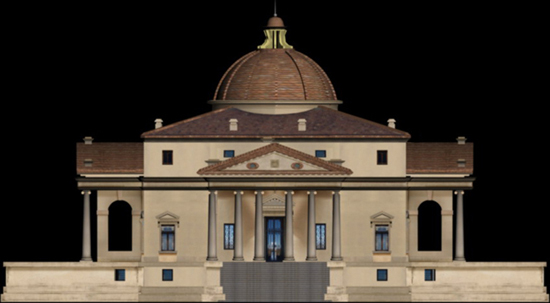|
3DVisA Resources 3DVisA Index of 3D Projects: Architectural and Urban Studies
Virtual Recreation of Palladio’s Villa Rotonda (1)
The Villa Rotonda, also known as Villa Capra or Villa Almerico-Valmarana, is one of the best known works by the Renaissance architect Andrea Palladio (1508-80).
It was built just outside Vicenza, Italy, in the countryside, as a retirement residence for the clergyman at the Vatican, Paolo Almerico. The work began in c. 1565/6. Although
the villa was inhabited by 1569 it was still unfinished by the time of Almerico’s death in 1589. The next owners, the brothers Odorico and Marco Capra
commissioned a student of Palladio, the architect Vincenzo Scamozzi (1552-1616) to complete the villa.
Palladio elaborated upon his own practice, including the design for the Villa Rotonda which he intended for an urban setting, in Quattro libri dell’ architettura,
published in Venice in 1570. His designs were based on a detailed study of classical Roman architecture, but the second book of this treatise indicates much consideration
given to the relationship of architecture to the surrounding landscape, aesthetics and functionality. The Villa Rotonda is considered a masterpiece in this respect.
Located on a hilltop, the perfectly proportioned and symmetrical structure consists of four pedimented, temple-front porticos, each approached by a flight of steps, and a central hall toped by a dome.
The popular name of the villa derives from the central, round hall (sala) which was designed 'for entertainments, banquets, weddings and similar recreations'. The sumptuous sculptural decoration was added over the years by various Italian masters.
However the appearance we see today differs from the original design. Scamozzi introduced a number of changes, most notably a flatter dome. The Villa Rotonda and other architecture
by Palladio in the Veneto region have been inscribed on the UNESCO World Heritage List in 1994.

Fig. 1. Villa Rotonda. Digital reconstruction by Daniela Sirbu. © The WestGrid I-HEARD II Project. Reproduced with kind permission.
The Villa Rotonda has been a popular subject for computer modelling. In this project, a computer reconstruction of Villa Rotonda is used as a basis
for a hybrid environment to integrate previously accumulated tacit and explicit knowledge with the individual researcher playing the role of an
active interface between the knowledge space and the virtual space. The architecture of the past is analysed as a virtual environment with new specific properties building
on the original architectural design. The concepts of space and place are analysed in the context of the digital environment. This is a pilot project for
the larger WestGrid project, Immersive Hybrid Environments for Architectural Research and Design (I-HEARD) funded by the Canadian Foundation for Innovation.
The project involves traditional 3D modelling (in progress) of the exterior of the Villa Rotonda. Future possible developments include modelling
the inside of the villa, and modelling for the specific requirements of a VR environment in Virtools. The aim of the latter is to develop the villa as a
Virtual Reality environment to be navigated as an interactive/immersive experience.
Project dates: August 2003-August 2009
Resource status: The WestGrid-VR website is under construction at the University of Lethbridge.
Contributors: Principal Investigator, Daniela Sirbu, Faculty of Fine Arts, Department of New Media, University of Lethbridge, Canada.
Project Funding: WestGrid Collaboration and Visualization Program for University of Lethbridge, Canada.
Sources and further details:
The project website is forthcoming.
For bibliography, photographs and plans see 'Villa Rotonda', in 'Palladio and the Veneto' Centro
Internazionale di Studi di Architettura Andrea Palladio.
Information supplied by Daniela Sirbu. Record compiled and additional research by Anna Bentkowska-Kafel. Last updated: 17 December 2006.
3DVisA gratefully acknowledges the help of Assistant Professor Daniela Sirbu with preparation of this record.
© I-HEARD and 3DVisA, 2006.
Back to the list of 3D projects
| 